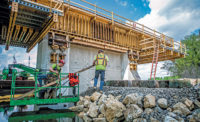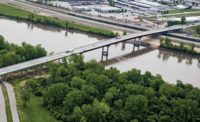Construction begins in March to turn the Rock Island Bridge, a Kansas River railroad span, into a route to fun.
Built in 1905 to transport millions of cattle to the Kansas City Stockyards, this project will renovate the bridge into a party place with restaurants, bars that feature railroad ties as footstools, a walking and running trailhead, and a second-story enclosure for events like weddings.
The original bridge had two trusses each spanning 302 ft. In 1912, a third span was added. The additional span was required after the east bank of the river was reconfigured to reduce the likelihood of flooding. In all, the bridge spans 702 ft.
L.G. Barcus and Sons of Kansas City, Kan., has the contract to remove old railroad ties and 1,400 ft of rails. The company also will elevate the bridge 4 ft to take it out of the flood zone and even it with the levees that are being raised by the Army Corp of Engineers in a necessary but unrelated project. Kansas City-based MultiStudio architecture is designing the project. Kansas City contractor Centric is building out the entertainment spaces, including bars, restaurants, kitchens and bathrooms.
The bridge project is expected to cost about $12 million. That doesn’t include the $257.7 million that the Army Corps is spending to raise 17 miles of levee and flood wall improvements to the area adjacent to the railroad bridge on both sides of the river.
While the river is mostly the state line between Kansas City, Mo., and Kansas City, Kan., the bridge is entirely on the Kansas side. The state line in that area is a parking lot south of the river. The bridge was originally owned by Kansas City, Mo., which deeded it for $1 to Kansas City, Kan., to facilitate the recreation project.
Barcus has a long history with this bridge. In 1949, as part of a $10 million federal flood control program, the Army Corps awarded a $392,000 contract (more than $4 million in 2023 dollars) to the company headed then by the great-grandfather of the current owner to install devices so the bridge could be raised and lowered in case of flood. “We put the original lift gates in and all the lifting mechanisms. And now we're going to go back and raise it another 4 feet using the same towers and some of the same gears and mechanisms,” says Daniel Gibson, Barcus’ vice president of estimating structures division.
Barcus is adding 400 tons of new steel to support expansions but, overall, the bridge is in great shape, says Gibson. An earlier safety survey by TranSystems, a Kansas City, Mo., engineering firm, hired to assess the condition, concurred that the bridge was strong and safe to carry as much as 3.16 million lbs. “They don't use salt on rail lines, so the bridge was never salted. It doesn't have that corrosion issue. And it was decommissioned about 40 years ago and has not been used, so it doesn’t have the wear and tear on it that other bridges would have had,” Gibson says.
Besides raising the bridge, Barcus is widening it. Currently, the east part of the span is 18 ft wide. It will stay the same and be devoted to a walking and bike trail. The center section will be widened to 65 ft, cantilevered over the water. A second floor will be added over roughly two-thirds of the center span to be used as an event space. The west span will be widened to between 45 and 60 ft to accommodate viewing stations and other multi-use facilities, Gibson says.
MultiStudio Vice President architect Sam Loring says designing this project has challenges. “We're converting it into a public use crossing with public restrooms. There's going to be a bar with some seating on the expanded central platform, and we're going to have two small kitchenettes – little restaurant outposts. One of the big problems is the plumbing. How do you get water and waste on and off the bridge without it freezing and leaking? We’re installing a utility chase where we'll be running all of our electrical and plumbing, heat traced and accessible for any kind of maintenance, but we’re still going to have the possibility of freezing pipes because we won't have a full-on heating system on the bridge,” Loring says.
The trail will be open year round, but the rest of the facilities will be closed for three or four winter months. “We’re installing drop-down curtains for inclement weather and use in the colder seasons, but the cost to fully heat and cool was going be too much,” Loring says.
“The challenge for us is going to be working in weather and wind on a bridge,” says Nate Eubanks, director of operations for general contractor Centric. “Other than that, it's fairly typical construction. It's cold form framing, metal skin, some poly stuff that we're very familiar with. But obviously, we’re working 40 feet above the water,” he adds.
Meanwhile, Kansas City is enjoying a renaissance that will be expanded by this bridge project and other big infrastructure improvements. The Army Corps' levee and floodwall improvements is worth $540 million in two states, fully funded by the U.S. government, according to Sarah White, project engineer, United Government of Wyandotte County and Kansas City (UG of WYCO/KCK). These levee improvements will diminish the flooding risk, allowing development of riverfront property in both states, including what used to be the Kansas City stockyards. The levee project is expected to be completed in the spring of 2026.
Already there is a rush of sales and permitting. The investments include the renovation of the Hy-Vee former pro sports arena into a recreational complex, surrounded by new housing on the Missouri side. On the other bank, a luxury condo complex is partially finished, and developers are seeking to build a variety of retail, including hotels and restaurants.
WYCOKCK has spent $2 million on the railroad bridge part of the project. It is providing access to the bridge, which can’t be completed until the flood walls are finished in that area, White says. WYCOKCK is responsible for utilities and ADA ramps and elevators to the bridge, as well as parking lots.
“We’re laying the foundation for future riverfront development to come,” White says.
The driving force behind the project is Mike Zeller, CEO of Flying Truss LLC, who has worked for a dozen years to make this bridge recreation center a reality. He went to high school not far from the bridge and recalls some good times around it. He was boating on the river with his wife and three children when it occurred to him that the bridge could still support more fun. A former development executive for Kansas City Public Television, he spent a decade seeking money and support to make the idea work.
.jpg?1677004525)



